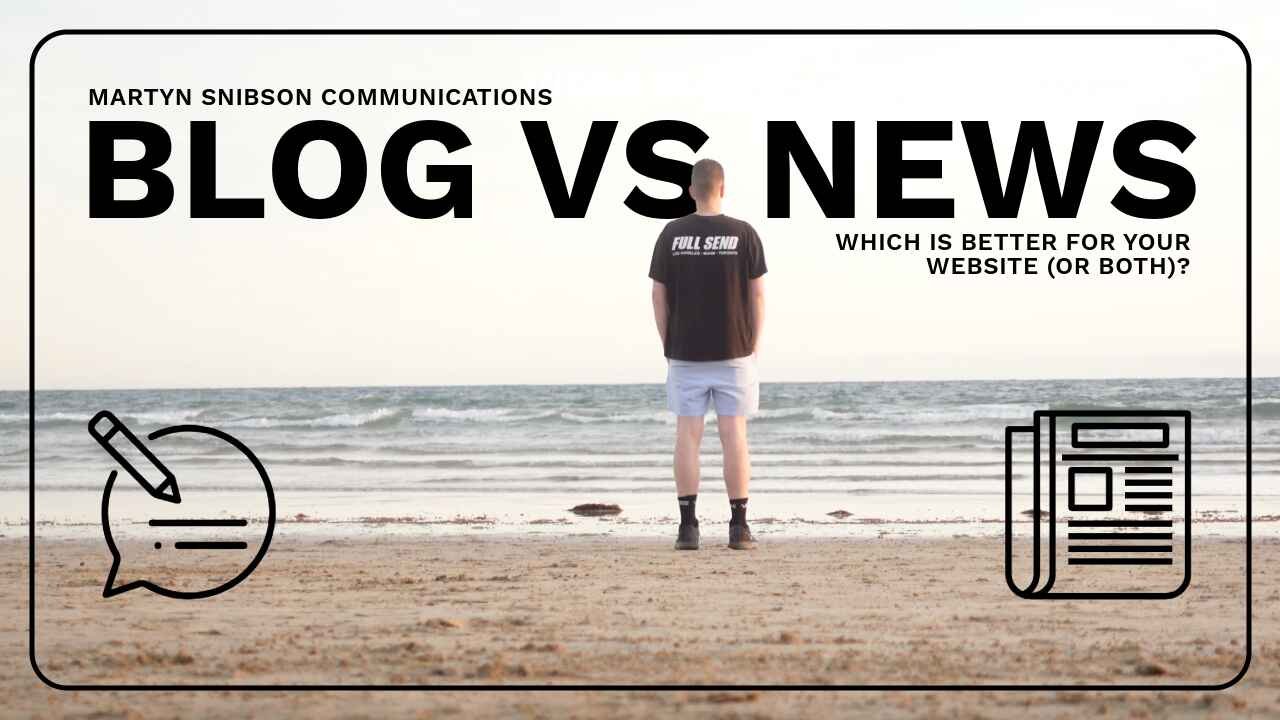
Still undecided between incorporating a blog vs news (newsroom) section on your website? When used effectively, blogs and news sections can drive traffic, boost SEO, enhance link-building, and accelerate your brand’s visibility. These content formats also play pivotal roles in Public Relations (PR) and Digital PR (DPR) efforts, helping you engage journalists and build meaningful relationships. So, how do you decide which is right for your website for maximum impact—or if you need both?
Lately, I’ve been curious about why businesses choose blogs over newsroom sections (or vice versa, or both) and whether one offers more significant audience and SEO benefits.
First, let’s say it, when you’re thinking about creating a new website, you are likely to hear advice from marketers, SEO specialists, and public relations practitioners along the lines of:
- “You need a blog!”
- “What about a news section or newsroom?”
- “Having a media (or press) release area on your website will do the trick!”
To be honest, it can be overwhelming to navigate. Should you include a blog, a newsroom, or both? And how can you maximize their potential?
Let’s break it down: What is a blog? What is a newsroom? How do these content areas align with your website goals, audience needs, and SEO strategy? This article will also delve into modern examples of how today’s businesses and organisations are using these website sections in their own marketing and public relations strategies.
Shall we dive in?
Table Of Contents
What Is A Newsroom (News Section) On A Website?
Essentially, a newsroom, or news section, is a dedicated content area on a website providing users with helpful information and factual updates about a corporation or organisation.
As described by Neto et al. (2019), it’s a content hub facilitating the “cooperative production of content and communication between newsroom professionals and news prosumers.”
A newsroom on a website might include information such as:
- Up-to-date information regarding a company or organisation.
- Industry-specific news and updates.
- Fact sheets, whitepapers, infographics, and charts for deeper insights.
The Difference Between A Media Release And A News Article
While newsrooms (news articles) and press (media) release sections on a website might seem similar, their purposes differ. A newsroom serves a broader public audience, delivering factual updates or educating readers about a company’s activities. In contrast, a media release is a component of a strategic communications plan explicitly aimed at the media to inform, persuade, or promote.
What Is A Blog On A Website?
At its core, a blog is viewed as a more intimate form of communication between an individual author or organisation and their readers. Blogs are often interactive; they are commonly used for personal commentary or business content to inform and educate readers on a wide range of topics. Blogs can also combine a strong sense of an author or business’s persona, interests, and point of view.
For a business, having a blog is the cheapest, easiest, and quickest content format. Blogs are easy to understand on search engines for indexing, organic traffic and link-building purposes.
Blog articles on a website can consist of:
- Opinion pieces reflecting an individual or organisation’s opinion on a subject matter.
- Interview articles that transcribe a conversation to captivate and inform readers on various topics, insights, and experiences.
- Product reviews providing expert critique and evaluation of a product or service.
- How-to guides assisting a reader in gaining knowledge on a topic or skill.
The chosen topics and content on a blog for a business work best depending on a website’s niche, industry, topic, or keywords. These can be dictated through keyword research and website authority and can be achieved through acquiring backlinks.
What Are The Key Differences Between A Blog And A News Section?
When you compare the key differences between a blog and a newsroom (news) section on a website as a way to “connect people with ideas and information”, the key contrasts lie in the:
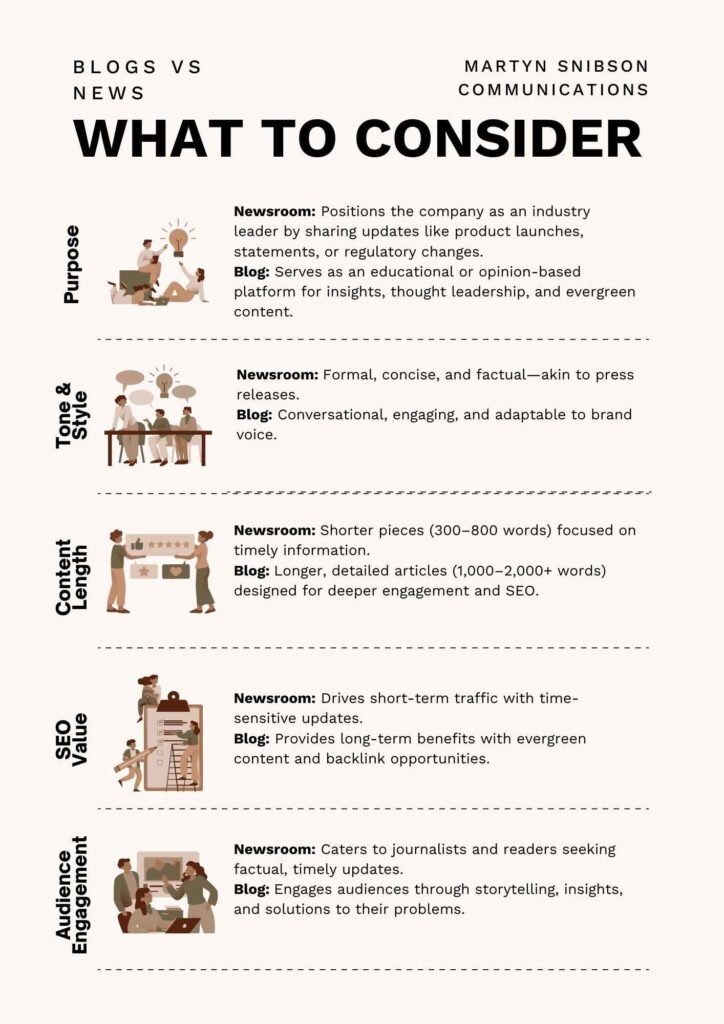
- Purpose
- Newsroom: A newsroom focuses on showing leadership as a company or industry leader to an audience, whether it’s for a product launch, company statement, or industry regulatory changes. It gives an impression to the audience that your company or organisation is updated.
- Blog: The role of a blog on a website is to serve more of a lecture to provide insights, guidance, or opinions on a multitude of topics. It’s perfect for thought leadership, how-tos, and evergreen (or Lo-Fi) content.
- Tone and Style
- Newsroom: A news section of a website is delivered in a formal, concise and objective manner. Similarly to doing a press or media release, it’s more about facts and updates without the fluff. In a dynamic media environment, news sections and media releases are structured to give the audience and journalists the exact information they need in a media environment where time is of the essence.
- Blog: Blog articles are more informal than news sections or media releases, but the tone and style can also depend on a company or organisation’s industry. Blog content is much more conversational, engaging, and, in many cases, opinion-driven. Therefore, blogs allow the flexibility to give an author, company or organisation a brand voice of authority to develop a loyal relationship acclimated through the tone within the content.
- Content Length
- Newsroom: Content within a newsroom or news section is short and to the point. Aiming for 300-800 words should be the objective in most cases. Specifically, if you are using the newsroom as part of your public relations strategy, journalists reading and taking notes want the key information and don’t have the time to read fluff.
- Blog: Blog content is more detailed and explorative on various topics. Blog articles can typically range from 1000-2000+ words depending on the topic and SEO keyword competition.
- SEO Value
- Newsroom: A Newsroom or news section is great for short-term spikes due to the time relevance of the updates you are providing, especially when it could be on a trending topic.
- Blog: Blog content can be considered more evergreen in nature, boosting search rankings and attracting backlinks over time. Especially if they are pages that are continually updated to include timely and updated information, insightful blog articles on an e-commerce website can also serve as a guide or link-bait, guiding consumers before their eventual purchase of your product or service.
- Audience Engagement
- Newsroom: A newsroom or news section caters to readers and journalists who seek timely updates and factual information.
- Blog: Blogs are designed to engage readers looking for in-depth insights and answers to questions or queries and help readers find a solution to their problems.
Can You Use Both A News And Blog Section On A Website?
The short answer is yes; you can include both a news and a blog section on a website when it makes sense to do so.
For smaller organisations, it might not be practical to manage both a newsroom and a blog. In such cases, focusing on a blog might be the better option to build your online presence and amplify your voice.
On the contrary, if you are a larger organisation, it might make sense to include both a blog and news section on your website because of the often sheer volume of stories, news and updates that journalists, stakeholders and target audience groups may need to know.
As best said by Trevor Young in “Content Marketing for PR”
“The key is to understand the purpose of each channel: What are you trying to achieve? Who’s the audience? What sort of content are you going to produce, and how often?” – Trevor Young
Examples Of Companies Using Blogs And Newsrooms
Here are five examples of companies and organisations that are taking advantage of news and blog sections on their websites. Examples include websites that include either a blog, news or media release section or a variety of all combined:
Bendigo and Adelaide Bank (Bendigo Bank):
Bendigo Bank is known as one of Australia’s leading financial institutions, predominately in the retail banking sector. The Bendigo Bank website has both a blog and a media centre section.
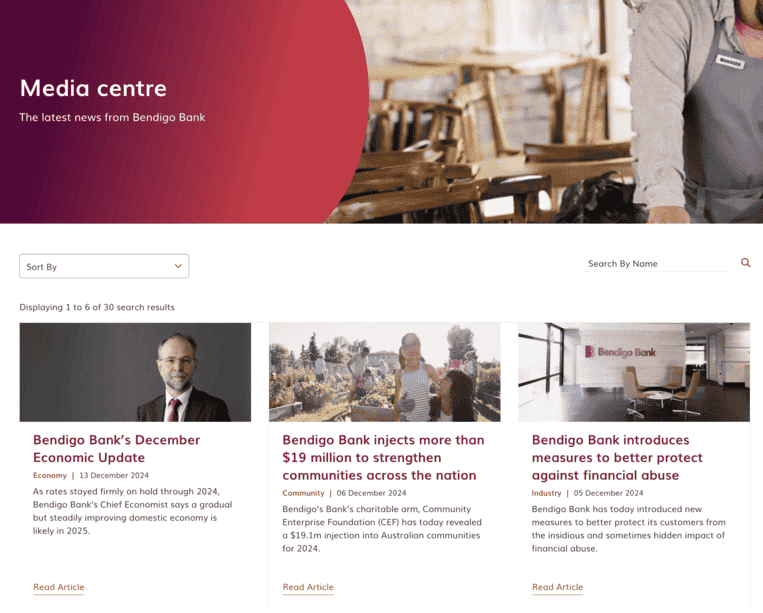
The Bendigo Bank Blog provides its users with valuable tips and advice on personal, business, and savings topics. With new articles released weekly to fortnightly, it provides its users with financial education, community stories, small business advice, social responsibility and updates/ announcements. Not only does its blog engage Bendigo Bank’s customers, but it also builds trust and reinforces Bendigo Bank’s authority and reputation as a community-centric organisation.
The Bendigo Bank Media Centre, on the contrary, is more about delivering content as part of their media relations strategy, which is produced by their media team. It provides users, journalists and stakeholders with announcements about company initiatives, financial updates, partnerships and community projects. A particular article that shows a present public relations and corporate social responsibility strategy is an article written by Bendigo Bank on the 6th of December 2024 called “Bendigo Bank injects more than $19 Million to strengthen communities across the nation.”
Raising Cane’s
The Raising Cane’s Newsroom is a perfect representation of Raising Cane’s playing to their strengths as a brand and the perfect delivery of a comprehensive marketing strategy. Called “The World of Cane’s,” Raising Cane’s news section divides its tags into six sections for simplicity being:
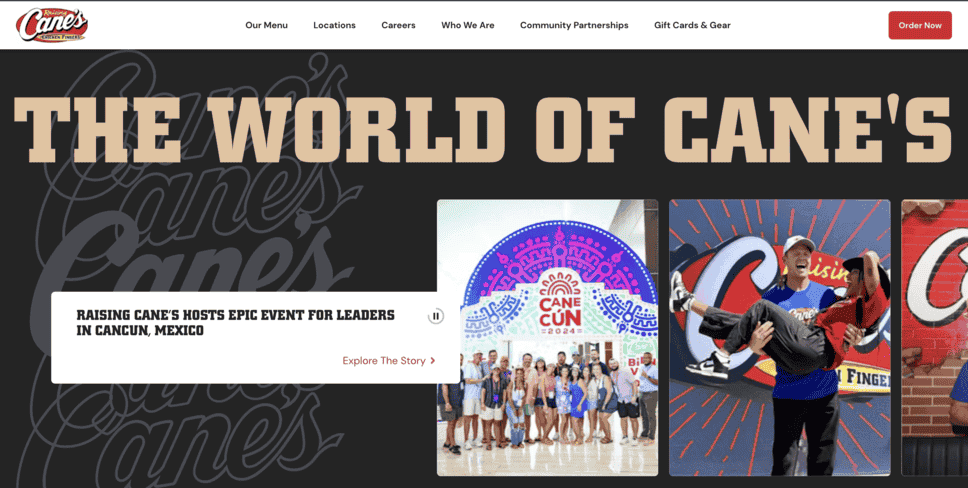
- Community
- Crew
- In the News
- Location
- Pop Culture
- What’s Happening
Raising Cane’s brand and marketing strategy is about leveraging pop culture and community involvement to connect with a younger demographic, and a lot of this kind of news content is being highlighted on Raising Cane’s website. For example, on November 9th 2024, Raising Cane’s released a news article called “Heading Back to School with Chance the Rapper to serve Chicago Students”.
Raising Cane’s “news section” serves as a resource for customers and stakeholders to stay informed about Raising Cane’s developments and involvement in the community.
The Pokemon Company (International)
The Pokemon Company International adopts a dual approach by maintaining both a news section and a separate press site.
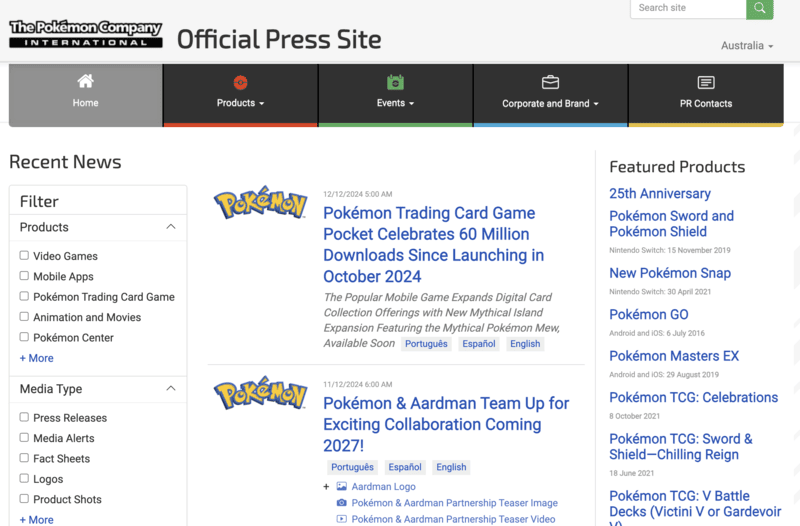
How the Pokemon Company International has organised its website is comprehensive and well-organised, and it is obvious that they have identified the purpose of each channel and helped ensure their different audiences have accessible information that is relevant to them.
The Pokemon Company’s News portion of their website is for the general public and dedicated Pokemon fans, providing updates on Pokemon games, events, merchandise, and other Pokemon-relevant content.
This might include announcements on new Pokemon video game releases, Pokemon Trading Card Game expansions, in-game events, collaborations, and community updates. Its intention is to keep its loyal fan base engaged and up-to-date.
Meanwhile, their press site caters to journalists and media professionals, providing official press materials, logos, and assets for consistent and accurate media coverage. This separation allows Pokémon to serve its fan base and industry stakeholders effectively.
Separating the news and the press release sections of their website helps the Pokemon Company to effectively meet the needs of both their fanbase, media and industry stakeholders.
Bondi Sands
Being an Australian leader in Self Tanning, Sun, Skincare and Body products, Bondi Sands’ Blog section of their website is presented in a creative way to cater to the needs of customers who are interested in their product range, as well as those who want to get the best results out of their products.
Instead of the traditional clickable ‘Blog’ page that a user sees when on the homepage, this portion of the website has opted to be called ‘tips and tricks’ instead. You can find tips and tricks on topics such as:
- “Why you should be using Vitamin C every day”
- “TikTok Tan Hacks”
- “Your guide on using retinol serum”
Bondi Sands Blog helps customers enhance their experience and achieve the best results while also addressing concerns or questions they might have about Bondi Sand’s product range.
Qantas
Qantas effectively uses both a blog and a newsroom to cater to different audiences and goals.
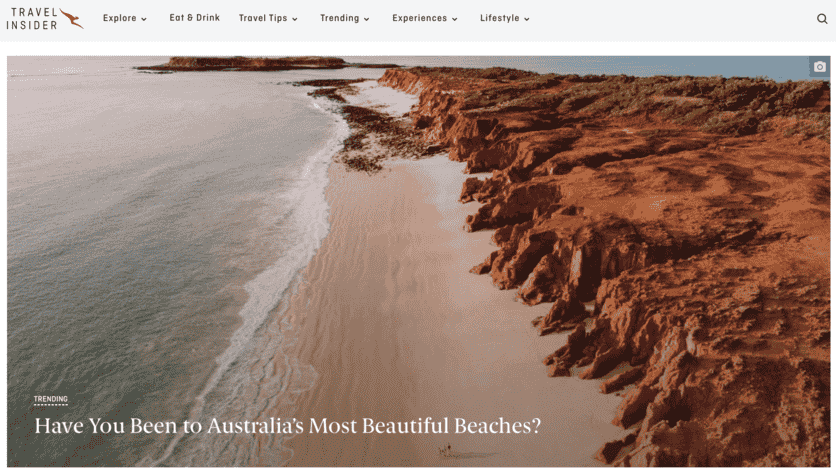
Their blog, “Qantas Travel Insider”, inspires travellers with destination guides and curated travel tips, catering to vacationers seeking unique experiences.
Meanwhile, the Qantas Newsroom communicates corporate updates, media releases, and crisis management information, targeting journalists, investors, and industry professionals.
Together, these platforms reinforce Qantas’ position as a trusted and innovative brand in the travel industry.
Final Word
When used strategically, both can drive traffic, boost SEO, enhance link-building, and elevate your brand’s visibility. They also play pivotal roles in Public Relations (PR) and Digital PR (DPR) efforts, helping you engage journalists and amplify your message.
As businesses evolve, the decision to adopt a blog or newsroom often reflects their unique goals, audience needs, and SEO strategies. Both options are incredibly valuable but serve different purposes. A blog connects with readers through thought leadership, education, and conversational content, while a newsroom establishes credibility and authority with timely, factual updates.
The key takeaway? You don’t have to choose just one.
Remember, content isn’t just about filling a page—it’s about creating value, building trust, and driving meaningful connections. Start planning your blog or newsroom today to make a lasting impact.
